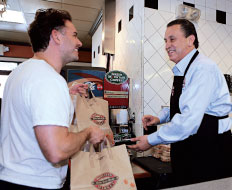When George Michel took the chief executive reins at Boston Market in October 2010, he inherited a concept with a tumultuous 25-year history that included bankruptcy, a headline-grabbing purchase—and subsequent sale—by McDonald’s, uneven numbers, and fading consumer interest.
In no time, though, Michel instituted a number of changes to stabilize Boston Market, including one unusual initiative: making interaction with restaurant guests one of his top priorities. “Being close to the customer is critically important,” he says. “I get to learn what they value, what they appreciate.”
On field visits to Boston Market stores, Michel frequently works the dining room, engaging customers in conversation about their visit to the restaurant and seeking feedback on the good, the bad, and the ugly.
“Those conversations provide a good understanding of what’s happening at the restaurant and how customers perceive us and our food,” says Michel, whose leadership has sparked two-dozen consecutive months of same-store sales increases and reignited store development after a six-year lag.
But Michel isn’t the only restaurant leader adding direct customer interaction to the long list of traditional corner-office tasks.
Togo’s CEO Tony Gioia estimates he spends 75 percent of his time in Togo’s restaurants speaking with customers about their favorite sandwiches, online ordering, or service times. Such conversations have spurred tangible changes at the 250-unit, California-based chain, he says.
When customers repeatedly called Togo’s ordering system confusing—its service model is more akin to a bank teller than a familiar sandwich assembly line—the brand stamped footprints on the ground to visually guide guests. And when customer inquiries about toasted sandwiches mounted, the company began toasting select sandwiches in test stores. In late 2010, the change was adopted systemwide.
“The best way for me to stay grounded with our business is to speak with the people who visit our stores,” Gioia says, adding that while he doesn’t take any guest comments as absolutes, the interaction helps him calibrate thoughts on pricing, product, and service.
Like Gioia, longtime Penn Station East Coast Subs president Craig Dunaway chats with customers during his in-store visits. He often asks guests open-ended questions about their experience at the restaurant. “If I stay in the ivory tower and don’t take the time to connect with customers, then I won’t know what’s going on,” he says.
In addition to restaurant visits, Michel also stays connected to Boston Market’s customers by receiving a copy of every consumer message submitted through the Boston Market website. Michel says he reads these notes—about 30 each day—“religiously” and has directly phoned customers for additional insights.
Like Michel, Dunaway reads customer comments and often pursues one-on-one dialogue. He says such contact reinforces areas of strength, spotlights weaknesses, and awakens opportunities to improve restaurant performance. “These interactions have helped us set a direction going forward,” Dunaway says.
Though customers occasionally request an unlikely change, Dunaway takes the time to explain and educate a customer on why a particular idea cannot be executed. “That type of response endears us to customers and helps differentiate us in a competitive industry,” he says.
The executive-guest interaction extends to social media, as well. Brand leaders such as Cinnabon’s Kat Cole and Wingstop’s Charlie Morrison use Twitter to connect with guests.
On Twitter, Cole banters with fans about new products and jumps into conversations taking place at the @Cinnabon Twitter handle. If a customer relays a negative experience, Cole is quick to contact the guest, request additional information, and provide her personal e-mail address.
Now in her third year as Cinnabon’s president, Cole says her interaction with customers helps her “understand the temperature” of Cinnabon’s guests. “You can see a trend of sentiment … and if you’re intuitive enough to find patterns, you can then start to ask real questions of your team and make the decisions that drive results,” she says.
At Boston Market, Michel’s direct interaction with guests has spurred a number of minor, yet valuable, changes. While he debated sodium-reduction efforts with his fellow Boston Market executives, it was Michel’s conversations with customers in the store that propelled the brand’s 2012 efforts to reduce sodium 15–20 percent and to remove salt shakers from tables.
Furthermore, Michel says interacting with customers allows him to personally test small ideas and gauge customer reaction. In one store, he had the idea of opening the front door for guests and welcoming them to the restaurant. With customers responding positively to that interaction, Michel instituted the “Step It Up” campaign, an initiative challenging staff to do the little things—helping a guest with multiple bags of food to his car, for instance—that can elevate the customer experience.
“I’m here as the innovation officer,” Michel says, “and being close to the customer helps me identify the next innovative steps for Boston Market.”












